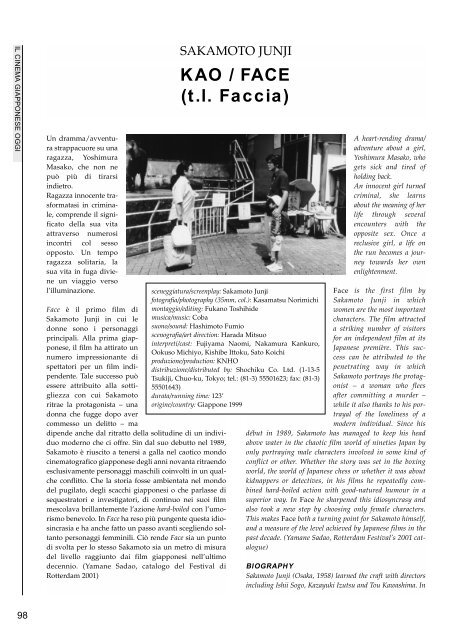Catalogo - Mostra internazionale del nuovo cinema
Catalogo - Mostra internazionale del nuovo cinema
Catalogo - Mostra internazionale del nuovo cinema
You also want an ePaper? Increase the reach of your titles
YUMPU automatically turns print PDFs into web optimized ePapers that Google loves.
IL CINEMA GIAPPONESE OGGI<br />
Un dramma/avventura<br />
strappacuore su una<br />
ragazza, Yoshimura<br />
Masako, che non ne<br />
può più di tirarsi<br />
indietro.<br />
Ragazza innocente trasformatasi<br />
in criminale,<br />
comprende il significato<br />
<strong>del</strong>la sua vita<br />
attraverso numerosi<br />
incontri col sesso<br />
opposto. Un tempo<br />
ragazza solitaria, la<br />
sua vita in fuga diviene<br />
un viaggio verso<br />
l’illuminazione.<br />
Face è il primo film di<br />
Sakamoto Junji in cui le<br />
donne sono i personaggi<br />
principali. Alla prima giapponese,<br />
il film ha attirato un<br />
numero impressionante di<br />
spettatori per un film indipendente.<br />
Tale successo può<br />
essere attribuito alla sottigliezza<br />
con cui Sakamoto<br />
ritrae la protagonista – una<br />
donna che fugge dopo aver<br />
commesso un <strong>del</strong>itto – ma<br />
dipende anche dal ritratto <strong>del</strong>la solitudine di un individuo<br />
moderno che ci offre. Sin dal suo debutto nel 1989,<br />
Sakamoto è riuscito a tenersi a galla nel caotico mondo<br />
<strong>cinema</strong>tografico giapponese degli anni novanta ritraendo<br />
esclusivamente personaggi maschili coinvolti in un qualche<br />
conflitto. Che la storia fosse ambientata nel mondo<br />
<strong>del</strong> pugilato, degli scacchi giapponesi o che parlasse di<br />
sequestratori e investigatori, di continuo nei suoi film<br />
mescolava brillantemente l’azione hard-boiled con l’umorismo<br />
benevolo. In Face ha reso più pungente questa idiosincrasia<br />
e ha anche fatto un passo avanti scegliendo soltanto<br />
personaggi femminili. Ciò rende Face sia un punto<br />
di svolta per lo stesso Sakamoto sia un metro di misura<br />
<strong>del</strong> livello raggiunto dai film giapponesi nell’ultimo<br />
decennio. (Yamane Sadao, catalogo <strong>del</strong> Festival di<br />
Rotterdam 2001)<br />
SAKAMOTO JUNJI<br />
KAO / FACE<br />
(t.l. Faccia)<br />
sceneggiatura/screenplay: Sakamoto Junji<br />
fotografia/photography (35mm, col.): Kasamatsu Norimichi<br />
montaggio/editing: Fukano Toshihide<br />
musica/music: Coba<br />
suono/sound: Hashimoto Fumio<br />
scenografia/art direction: Harada Mitsuo<br />
interpreti/cast: Fujiyama Naomi, Nakamura Kankuro,<br />
Ookuso Michiyo, Kishibe Ittoku, Sato Koichi<br />
produzione/production: KNHO<br />
distribuzione/distributed by: Shochiku Co. Ltd. (1-13-5<br />
Tsukiji, Chuo-ku, Tokyo; tel.: (81-3) 55501623; fax: (81-3)<br />
55501643)<br />
durata/running time: 123’<br />
origine/country: Giappone 1999<br />
A heart-rending drama/<br />
adventure about a girl,<br />
Yoshimura Masako, who<br />
gets sick and tired of<br />
holding back.<br />
An innocent girl turned<br />
criminal, she learns<br />
about the meaning of her<br />
life through several<br />
encounters with the<br />
opposite sex. Once a<br />
reclusive girl, a life on<br />
the run becomes a journey<br />
towards her own<br />
enlightenment.<br />
Face is the first film by<br />
Sakamoto Junji in which<br />
women are the most important<br />
characters. The film attracted<br />
a striking number of visitors<br />
for an independent film at its<br />
Japanese première. This success<br />
can be attributed to the<br />
penetrating way in which<br />
Sakamoto portrays the protagonist<br />
– a woman who flees<br />
after committing a murder –<br />
while it also thanks to his portrayal<br />
of the loneliness of a<br />
modern individual. Since his<br />
début in 1989, Sakamoto has managed to keep his head<br />
above water in the chaotic film world of nineties Japan by<br />
only portraying male characters involved in some kind of<br />
conflict or other. Whether the story was set in the boxing<br />
world, the world of Japanese chess or whether it was about<br />
kidnappers or detectives, in his films he repeatedly combined<br />
hard-boiled action with good-natured humour in a<br />
superior way. In Face he sharpened this idiosyncrasy and<br />
also took a new step by choosing only female characters.<br />
This makes Face both a turning point for Sakamoto himself,<br />
and a measure of the level achieved by Japanese films in the<br />
past decade. (Yamane Sadao, Rotterdam Festival’s 2001 catalogue)<br />
BIOGRAPHY<br />
Sakamoto Junji (Osaka, 1958) learned the craft with directors<br />
including Ishii Sogo, Kazayuki Izutsu and Tou Kawashima. In<br />
98
















